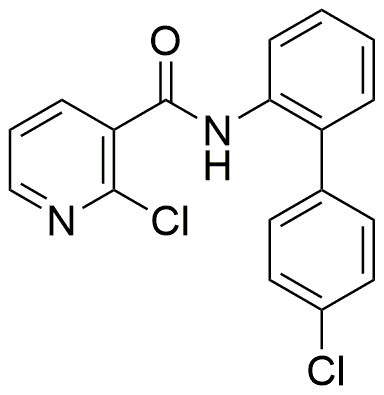Boscalid is widely utilized in research focused on:
- Agricultural Pest Control: This compound is primarily used as a fungicide in various crops, effectively controlling diseases like powdery mildew and botrytis. Its targeted action helps in maintaining crop health and yield.
- Integrated Pest Management: Boscalid is a key component in sustainable farming practices. It can be used in combination with other pest control methods, reducing the reliance on more harmful chemicals and promoting environmental safety.
- Research on Plant Pathogens: Researchers utilize Boscalid to study its effects on specific plant pathogens, helping to develop better disease-resistant crop varieties and improving overall agricultural resilience.
- Residue Management Studies: Its application in agriculture allows scientists to investigate residue levels in food products, ensuring compliance with safety regulations and consumer health standards.
- Formulation Development: The chemical is also used in developing new formulations for fungicides, enhancing efficacy and reducing toxicity compared to older compounds, which can lead to safer agricultural practices.
General Information
Properties
Safety and Regulations
Applications
Boscalid is widely utilized in research focused on:
- Agricultural Pest Control: This compound is primarily used as a fungicide in various crops, effectively controlling diseases like powdery mildew and botrytis. Its targeted action helps in maintaining crop health and yield.
- Integrated Pest Management: Boscalid is a key component in sustainable farming practices. It can be used in combination with other pest control methods, reducing the reliance on more harmful chemicals and promoting environmental safety.
- Research on Plant Pathogens: Researchers utilize Boscalid to study its effects on specific plant pathogens, helping to develop better disease-resistant crop varieties and improving overall agricultural resilience.
- Residue Management Studies: Its application in agriculture allows scientists to investigate residue levels in food products, ensuring compliance with safety regulations and consumer health standards.
- Formulation Development: The chemical is also used in developing new formulations for fungicides, enhancing efficacy and reducing toxicity compared to older compounds, which can lead to safer agricultural practices.
Documents
Safety Data Sheets (SDS)
The SDS provides comprehensive safety information on handling, storage, and disposal of the product.
Product Specification (PS)
The PS provides a comprehensive breakdown of the product’s properties, including chemical composition, physical state, purity, and storage requirements. It also details acceptable quality ranges and the product's intended applications.
Certificates of Analysis (COA)
Search for Certificates of Analysis (COA) by entering the products Lot Number. Lot and Batch Numbers can be found on a product’s label following the words ‘Lot’ or ‘Batch’.
*Catalog Number
*Lot Number
Certificates Of Origin (COO)
This COO confirms the country where the product was manufactured, and also details the materials and components used in it and whether it is derived from natural, synthetic, or other specific sources. This certificate may be required for customs, trade, and regulatory compliance.
*Catalog Number
*Lot Number
Safety Data Sheets (SDS)
The SDS provides comprehensive safety information on handling, storage, and disposal of the product.
DownloadProduct Specification (PS)
The PS provides a comprehensive breakdown of the product’s properties, including chemical composition, physical state, purity, and storage requirements. It also details acceptable quality ranges and the product's intended applications.
DownloadCertificates of Analysis (COA)
Search for Certificates of Analysis (COA) by entering the products Lot Number. Lot and Batch Numbers can be found on a product’s label following the words ‘Lot’ or ‘Batch’.
*Catalog Number
*Lot Number
Certificates Of Origin (COO)
This COO confirms the country where the product was manufactured, and also details the materials and components used in it and whether it is derived from natural, synthetic, or other specific sources. This certificate may be required for customs, trade, and regulatory compliance.


